-
Membership
Membership
Anyone with an interest in the history of the built environment is welcome to join the Society of Architectural Historians -
Conferences
Conferences
SAH Annual International Conferences bring members together for scholarly exchange and networking -
Publications
Publications
Through print and digital publications, SAH documents the history of the built environment and disseminates scholarship -
Programs
Programs
SAH promotes meaningful engagement with the history of the built environment through its programsMember Programs
-
Jobs & Opportunities
Jobs & Opportunities
SAH provides resources, fellowships, and grants to help further your career and professional life -
Support
Support
We invite you to support the educational mission of SAH by making a gift, becoming a member, or volunteering -
About
About
SAH promotes the study, interpretation, and conservation of the built environment worldwide for the benefit of all
The UNESCO Industrial Complex: Multi-Use Heritage in Germany and Belgium
Sarah Rovang is the 2017 recipient of the H. Allen Brooks Travelling Fellowship. All photographs are by the author, except where otherwise specified.
For all of their intrinsic claustrophobia, underground mine tours have been a reliable way to meet new people as the Brooks Travelling Fellow. A few months back, upon emerging from the mercury mine of Idrija in Slovenia and shedding my tour-mandated jacket and hard hat, I struck up a conversation with a young British-American couple. I’m always interested to hear why other visitors have made the journey to the industrial heritage sites I’ve been exploring, particularly younger people, who typically don’t have the same immediate connection to the sites that their parents’ or grandparents’ generations might. “Oh, we plan all our trips around UNESCO sites. We’re big UNESCO fans,” they told me. They had recently visited the saltworks at Arc-et-Senans (“You must go!”) and were already thinking ahead to their next UNESCO-centric trip.
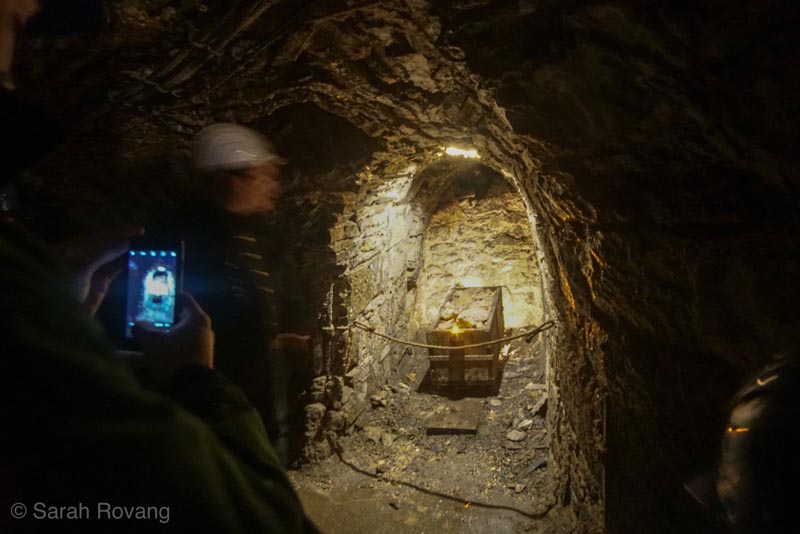
Spending time in tight quarters underground, such as at the UNESCO-inscribed mercury mine in Idrija, Slovenia, is an effective way to make new friends.
Although I’ve been to several dozen industrial UNESCO sites at this point in my Brooks Fellowship, I’ve rarely encountered other visitors who have explicitly chosen their itinerary based on this criterion. Status as a World Heritage Site is something that I’d wager most visitors understand is prestigious and ostensibly important, but hardly the raison d’être for a vacation. That certainly described my own level of understanding, even for many years as a fledging architectural historian. After all, I strolled around the University of Virginia for four years as an undergraduate with only a dim awareness that those Jeffersonian grounds were listed as a UNESCO site, and almost no comprehension of what that meant.
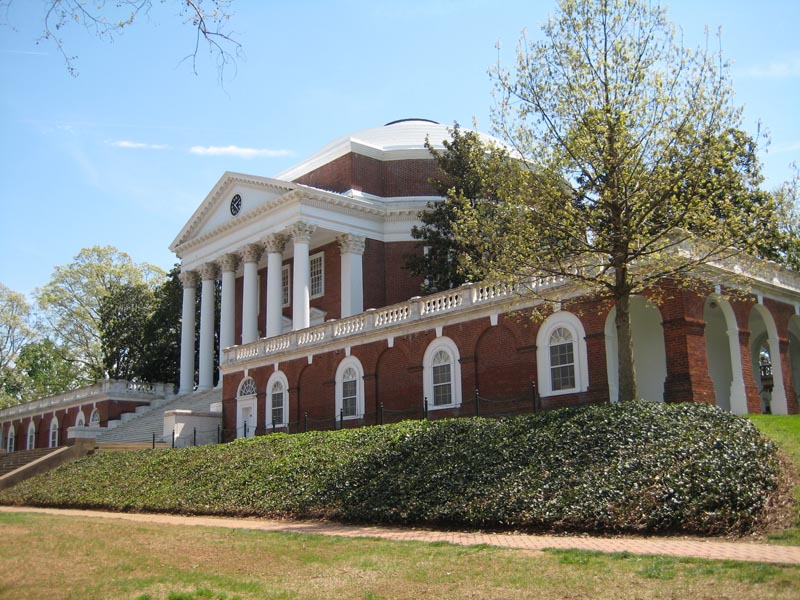
A 2009 shot of Thomas Jefferson’s famed rotunda from my undergraduate days at the University of Virginia, which I only later learned is also listed as a UNESCO World Heritage Site.
When I started planning my fellowship itinerary, I seized on UNESCO sites as a way of selecting non-European countries to add to my list of destinations. With little prior knowledge of how industrialization proceeded in areas outside of Europe and the U.S. (or what the tangible cultural heritage associated with those sites might be like), the UNESCO website became a springboard for sourcing industrial sites and regions around the world. The recent inscription of Japan’s 23 sites of the Meiji Industrial Revolution played a large role in my initial planning, as did the presence of Sewell Mining Town and the nitrate mines at Humberstone and Santa Laura in Chile. But I chose those sites without really understanding the system through which they had gained a UNESCO inscription, or the global politicking and conflicting ideologies of heritage preservation underlying the vetting process.
As I built my global itinerary, the UNESCO list represented a collection of sites already evaluated and approved by preservation professionals and historians following rigorous criteria of integrity and authenticity. But actually traveling to these sites, of seeing them for myself, in all of their often bewildering diversity, has made me realize the extent to which the very idea of a “globally important cultural asset” is not an inherent fact, but itself a human and imperfect construction coming out of evolving ideas of what constitutes global heritage. Understandably, expert consensus about which sites are most deserving of preservation and interpretation have developed substantially from UNESCO’s origins in the rubble and rebuilding following World War II. But the more I encountered that ubiquitous logo of the square monument enshrined in its harmonious, unifying circle, the weirder it seemed to me. There’s nothing neutral about declaring a landscape to be “globally important”—in fact that’s perhaps the most political statement a cultural organization can make. And the declaration isn’t just a polemical statement; the inscription of a UNESCO site can have real impact on how that site is administered and maintained by the nominating country, how it is impacted by tourism, and its potential for receiving international grants or financial aid.
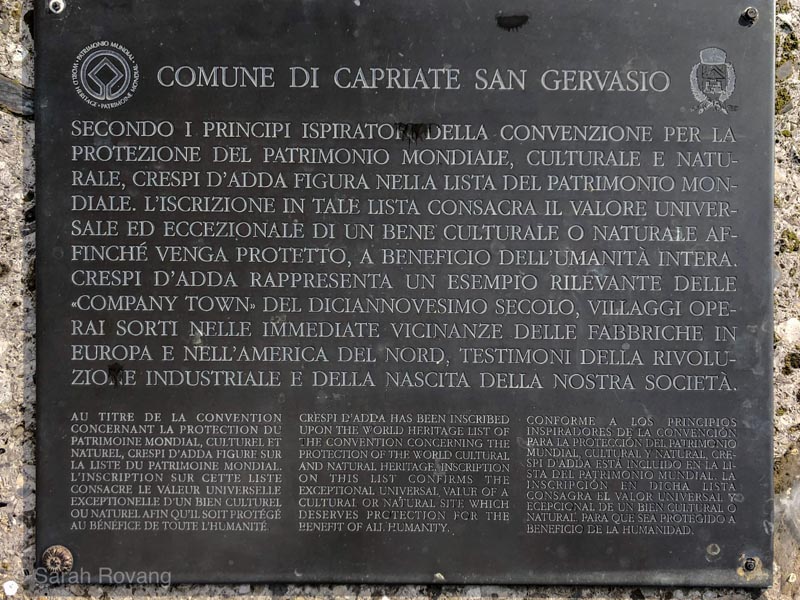
The caption of the typical UNESCO plaque at Crespi d’Adda near Milan, Italy, reads: “Crespi d’Adda has been inscribed upon the World Heritage List of the Convention Concerning the Protection of the World Cultural and Natural Heritage. Inscription on this list confirms the exceptional universal value of a cultural or natural site which deserves protection for the benefit of all humanity.”
Although the establishment of UNESCO was largely a reaction to the loss of tangible cultural properties in the devastation World War II, the World Heritage Convention is not a static piece of legislation, and its criteria for selection have evolved over time in response to calls for greater inclusiveness and diversity within the inscription list. Although UNESCO’s original vision of heritage conceived of historic sites as particular to certain groups and cultures, the 1972 World Heritage Convention articulated a new formulation; “a cultural internationalist view—one advocating global ownership of heritage.”1 In 1994, the Global Strategy for a Representative, Balanced and Credible World Heritage identified categories both over-represented and under-represented on the list, and shifted UNESCO’s approach in order to counterbalance the disproportionate inclusion of European vernacular and Christian religious architecture on the list.2
Using UNESCO listings as the basis for an industrial heritage itinerary would have barely been feasible even fifteen or twenty years ago. It was not until 1999 that a meeting of ICOMOS (the International Council on Monuments and Sites) specifically identified twentieth-century industrial heritage as an underrepresented category among existing UNESCO sites. Accordingly, in 2001, UNESCO commissioned a report (compiled and written by intern Michael Falser) entitled “Is Industrial Heritage under-represented on the World List?” Falser found that yes, industrial sites were broadly under-represented, accounting for only 4% of all World Heritage sites.3 Of the 28 industrial sites inscribed as of 2001, most were located in Europe or the United States, and the majority of those linked to “extractive industries” (i.e. mining).4
Over the last eighteen years, the inclusion of industrial heritage sites on the UNESCO list has accelerated rapidly. However, as with other attempts in the 1990s and early 2000s to diversify the list, it is still true that “wealthy states in the Global North were quicker to make use of these new categories than those in the Global South, due in part to the huge costs involved in preparing the World Heritage List nomination files.”5 From my own experience, I’ve noted that across World Heritage sites, tourism infrastructure, interpretation, and site maintenance vary dramatically. Comparing the economic resources and curatorial approaches I’ve seen this year in the World Heritage sites of Western Europe to those I encountered in other parts of the world in 2018 has driven home the extent to which preservation and interpretation are still contingent on local resources and practices, no matter how equalizing or democratizing the idea of “global heritage” might sound in theory. Even within the same country and even within the niche category of “industrial heritage” places, UNESCO sites can take broad range of forms.
As physical sites have become more diverse in terms of content and (gradually) geographic distribution, what constitutes “heritage” has also grown increasingly nuanced and heterogenous. The category introduced in the 1990s of “intangible cultural heritage” has proven an effective antidote to conventional, narrow Eurocentric interpretations of what constitutes material heritage (i.e. monumental architecture and culturally distinct vernacular building traditions).6 Among physical sites, nominating approaches have also proliferated, now including co-listings, international joint listings, and the broader consideration of heritage “landscapes” rather than isolated, independent structures. As cultural values change, so do heritage priorities. UNESCO’s newly expanded range of industrial sites indexes several significant contemporary concerns, such as the continuing climatological effects of industry on our planet and new respect for working class people and culture—concerns exaggerated by the aestheticization and dissemination of industrial ruins on social media.
With that in mind, and understanding that the induction of industrial sites as “world heritage” is a relatively recent phenomena, this month I want to examine how UNESCO sites can function on the local level as both hubs of heritage tourism and venues for other programs and functions through three case studies: the Zollverein Coal Mine Industrial Complex in Essen, the Fagus Factory in Alfeld, and the Major Mining Sites of Wallonia in Belgium. These sites not only exist within relatively close geographic proximity, but each can be considered living heritage—multifunction sites that serve not only as museums or historical interpretation of the industrial past but as office, dining, retail, art, event, and educational space. As our ideas about what constitutes “heritage” evolve, these sites present models for how sites might adapt to meet the challenges of changing economies and visitor expectations, balancing flexible multi-use functionality and strong interpretive programs.
Zollverein: UNESCO Site as Regional Heritage Hub
Inscribed in 2001, the Zollverein coal-mining and coking complex in Essen, Germany is one of the earlier UNESCO industrial sites added to the list around the same time that the report “Is Industrial Heritage under-represented on the World Heritage List?” was published. For sheer quantity of historical structures on a single site, Zollverein compares only to one other site I’ve visited: Humberstone nitrate mine in the Atacama Desert of northern Chile. But unlike Humberstone, which is a sprawling urban aggregation of imported styles, building materials, and changing industrial technologies, Zollverein is a veritable Gesamtkunstwerk. Born of Bauhaus-inspired modernism at that unsettling historical moment in Germany when Weimar idealism was beginning to buckle under the strain of a sluggish economy and the potent tug of nationalism, Zollverein is a universe ordered by architecture on a completely different scale than Humberstone.
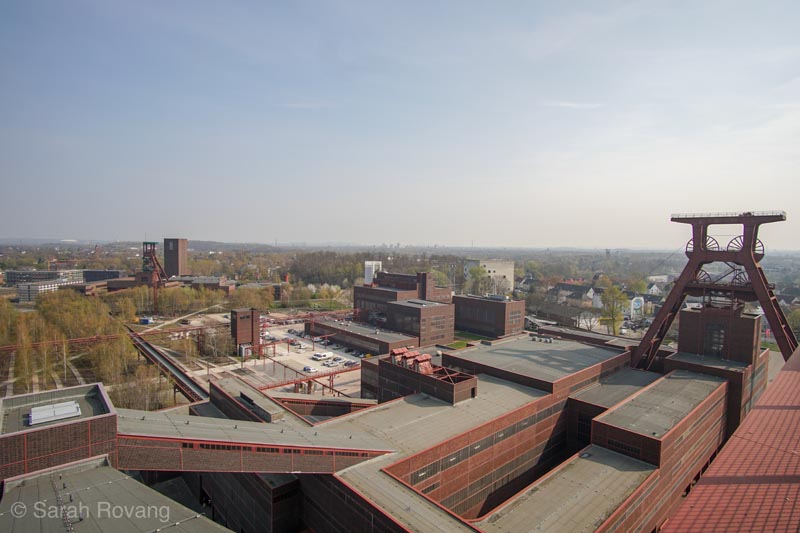
Looking out over Zollverein from the panoramic viewing platform atop the coal washery, it becomes clear how dramatically the landscape of the Ruhrpott was altered under industrialization. All of the hills that can be seen across the horizon are artificially-created, the result of decades of mounding up coal slag.
My first day at Zollverein was spent touring the innards of the coal washery, a towering, labyrinthine structure which has been repurposed into an interpretive center and museum. After a full day of climbing through old coal conduits and exploring the Ruhr Museum, I felt like I had just barely scratched the surface of what the site had to offer. When I returned a few days later, I stashed my things in a museum locker, put on my running shoes, and ran around the perimeter of the Zollverein, an approximately three mile loop that passes the complex around the coal washery, Shaft XII, Shafts 1/2/8, and the coking plant.
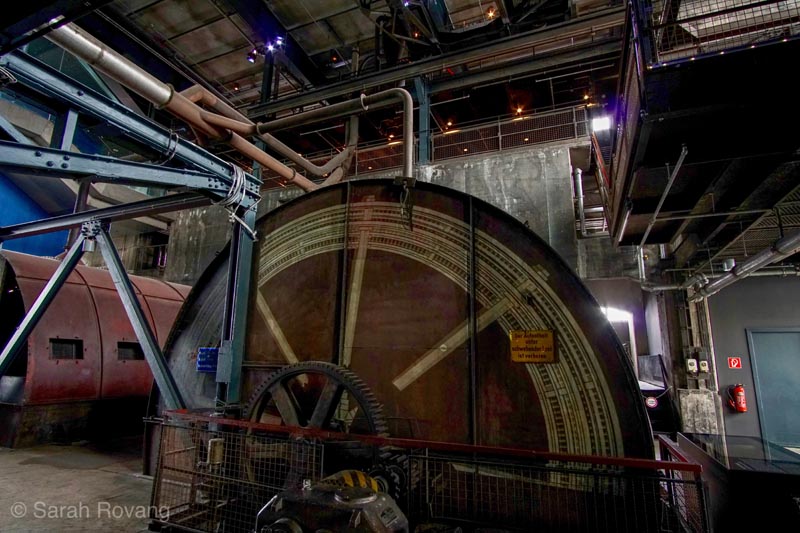
The interior of the coal washery, where I spent my first day at Zollverein. The tour of the interior features a series of projected, abstract animations that effectively demonstrate how machinery would have functioned during the washery’s operational years.
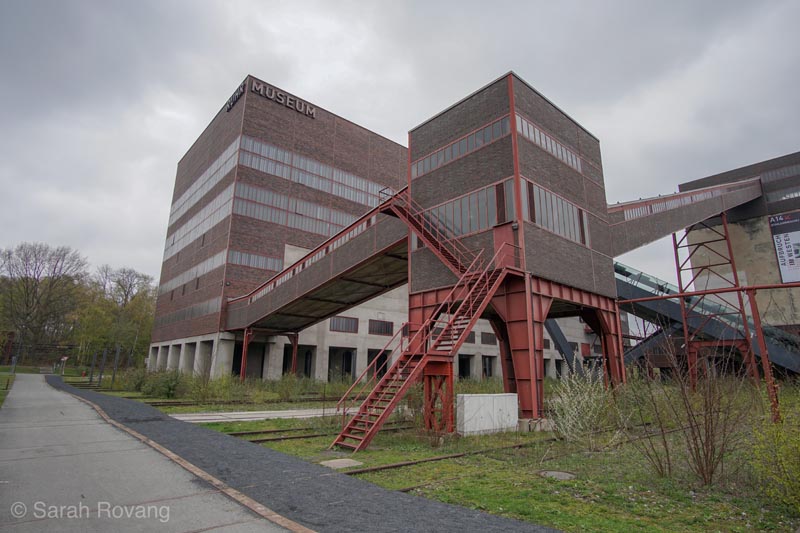
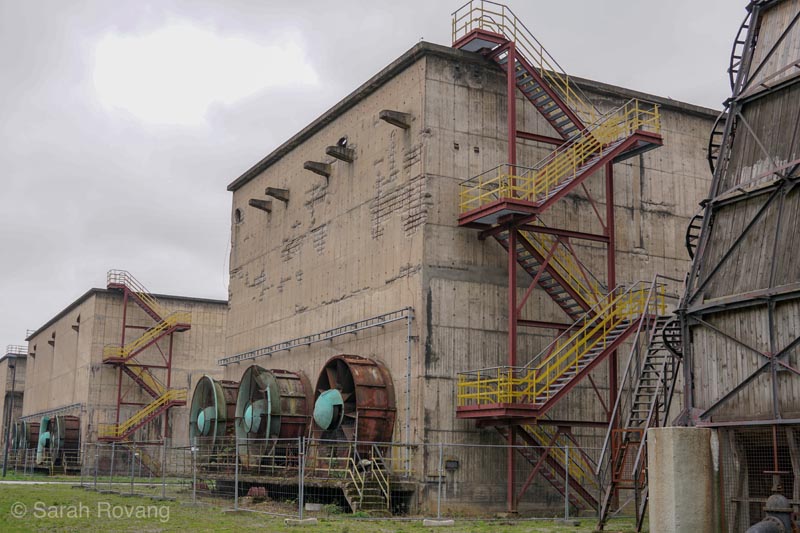
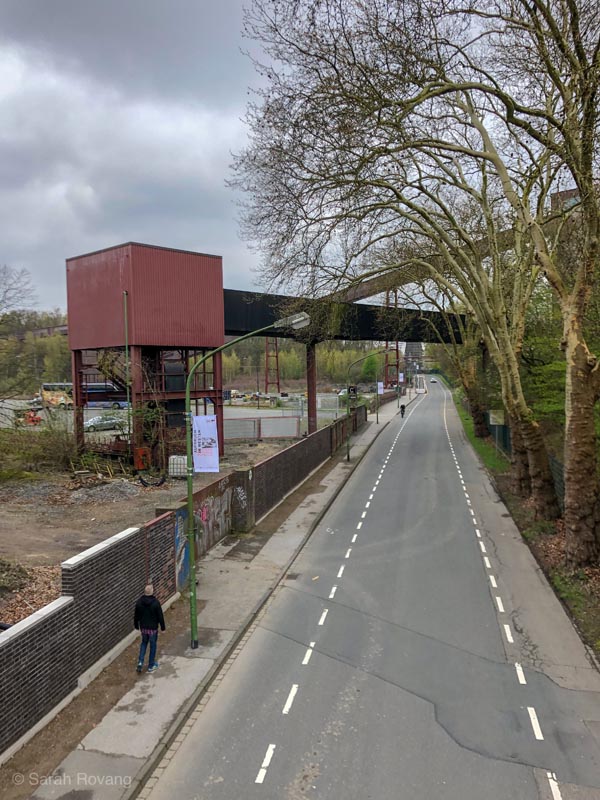
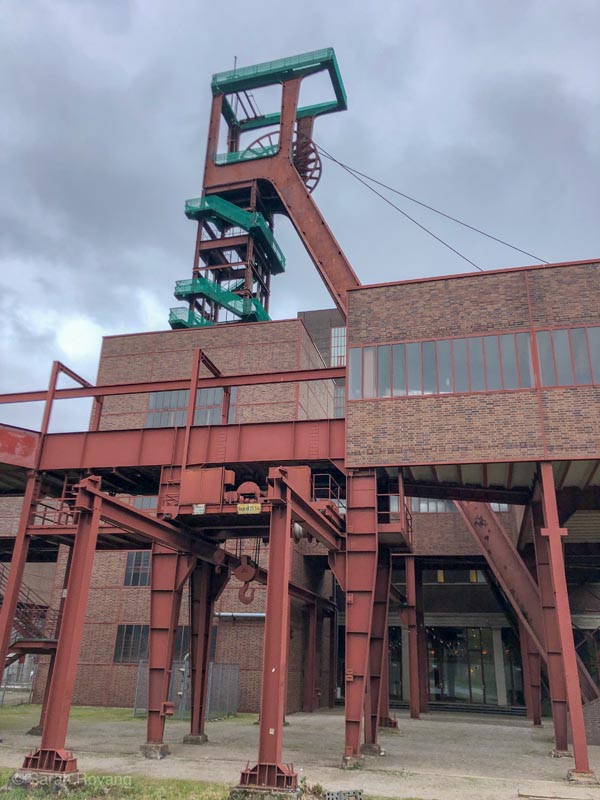
Photographs taken during my circumnavigation of the expansive Zollverein site. Many buildings near the old coal shafts and the behemoth coking plant have been adaptively reused as office and educational space, in addition to some dining and retail developments.
The scope of architectural unity at Zollverein is confounding, presaging the immense ambitions of wartime industrial architecture on both sides of the Atlantic. Designed by Fritz Schupp and Martin Kremmer and constructed between 1928 and 1932, Zollverein’s architectural language comprises a rhythmic functionalism of dark brick and red steel trusses. The historicizing symbolism that I’ve observed at many nineteenth-century industrial sites (such as the UNESCO company town of Crespi d’Adda) at Zollverein gives way to a new vision of rationalized twentieth-century industry: one anchored in an all-consuming capitalist efficiency rather than worker virtue and clean living. Yet, even as historicist utopianism gave way to pragmatism, the symbolic function is retained. Indeed, in the already heavily industrialized Ruhr Valley, Zollverein attained the status of icon and showpiece—the Doppelbock winding tower near Shaft XII reaching the level of regional industrial monument.
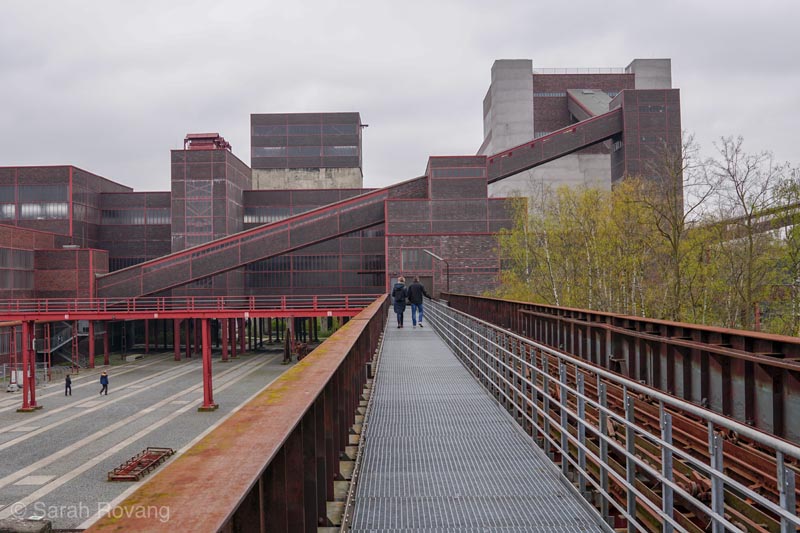
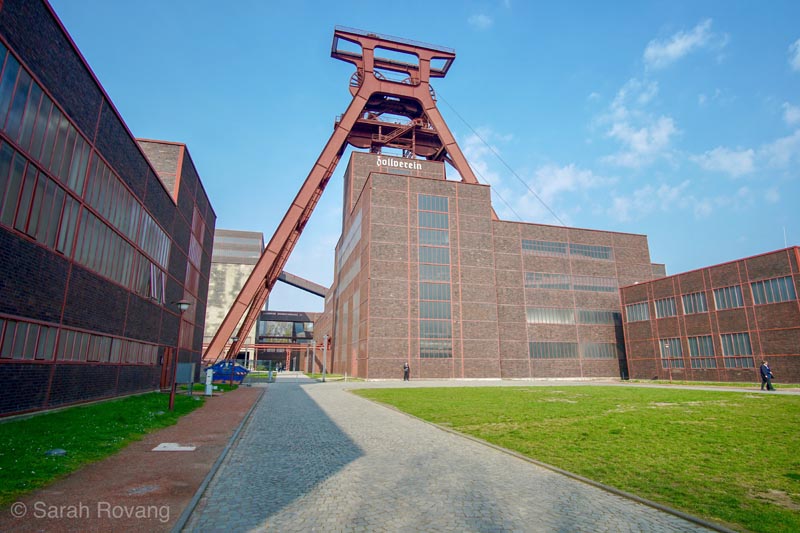
Above, the view of an elevated walkway on the return trip to Shaft XII reveals the architectural unity of Schupp and Kremmer’s design. Below, the Doppelbock winding tower, which today is still an icon of Ruhr Valley Industry; instantly recognizable on any number of souvenir t-shirts, mugs, and tote bags.
Coal mining at Zollverein persisted into the mid-1980s and the coking plant remained operational into the early 1990s. Recently, a cadre of prestigious international architecture firms have intervened in the industrial site, transforming Zollverein from intimidating 1930s relic into a visually and haptically appealing multifunctional heritage space. At the excellent Ruhr Museum in the former coal washery, Rem Koolhaas’s contributions include the bright orange escalator at the entrance—the “longest and highest open-air moving staircase in Germany”—and a smoldering neon stairwell.7 Norman Foster + Partners designed the interior of the Red Dot Design Museum in the former powerhouse, a jarring but seductive juxtaposition of industrial rust and contemporary design. On the southern edge of the site, the SANAA-designed Folkwang University of the Arts (2010) presents a point of architectural contrast, a punctured white cube amidst a field of dark brick and (when I visited) the pale green leaves of early spring.
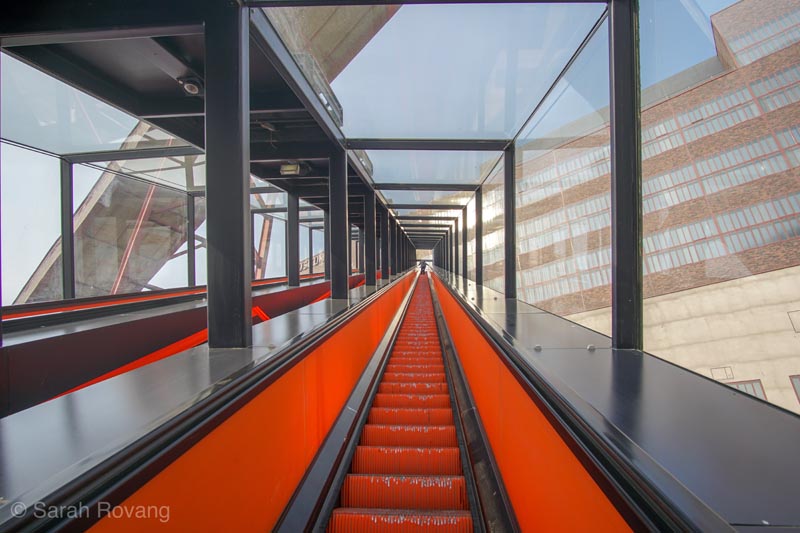
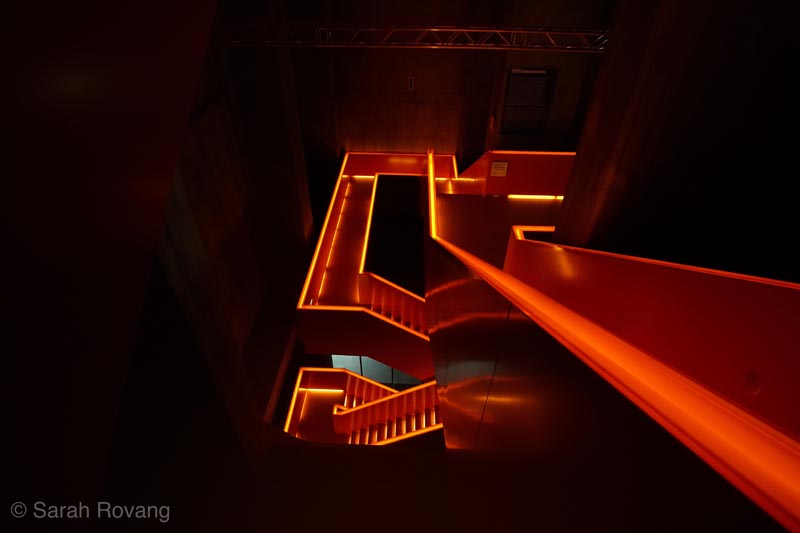
Rem Koolhaas of OMA executed the 2002 master plan of the Zollverein mine complex. The architect’s most visible and iconic contributions to the architectural appearance of the Ruhr Museum in the old coal washery are the exterior escalator and the interior stairwell, both in blistering shades of orange.
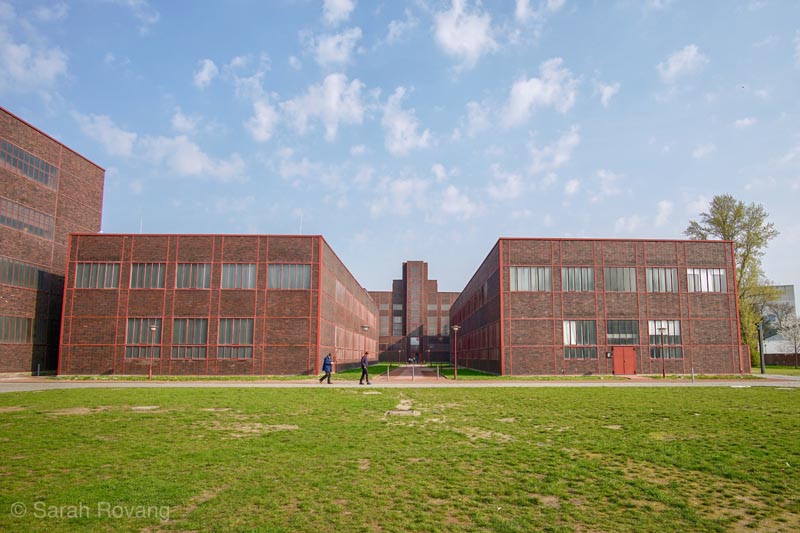
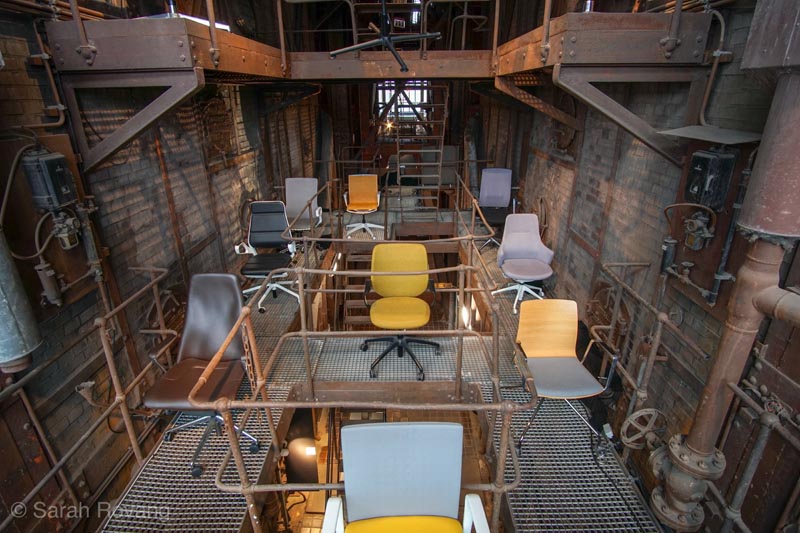
Foster + Partners reimagined the Zollverein powerhouse as the Red Dot Design Museum in 1997, before the overall site was inscribed on the World Heritage List. The reuse project capitalizes on the atmosphere and patina of the space, offsetting the rust of the former energy house with the sleek, new contemporary designs of the rotating Red Dot Design Awards collection.
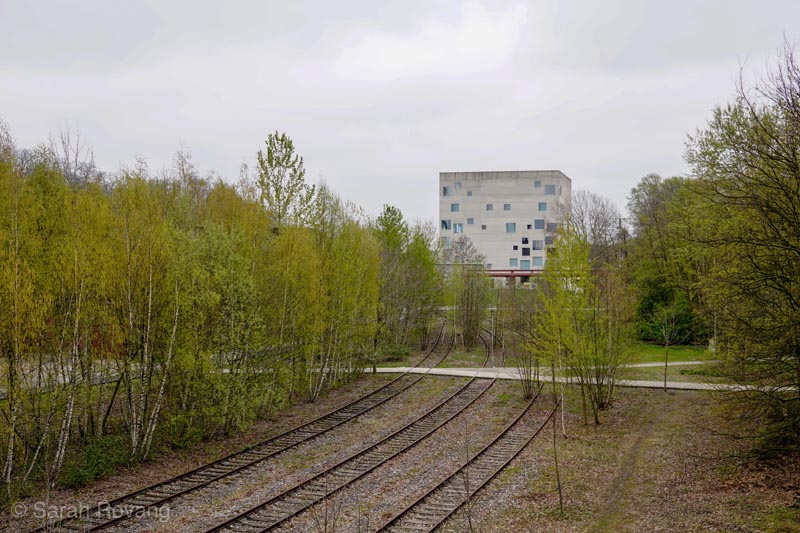
SANAA’S design for the Folkwang University of the Arts, opened 2010 on the Zollverein UNESCO site.
In its curation and administration, Zollverein has fully embraced its role as the one of the most historically significant and best-preserved industrial heritage sites in the Ruhr Valley, leveraging its UNESCO inscription as further justification for its centrality within this landscape. It has become the hub of industrial heritage tourism in the so-called Ruhrpott, a landmark seemingly embraced by both locals and tourists. Indeed, the only art in the AirBnB where I stayed in Essen was a massive nighttime photograph printed on canvas showing Zollverein’s iconic Doppelbock headgear, and the only non-IKEA kitchen items were the “I ❤️ Ruhrpott” mugs featuring a stylized Zollverein skyline.
In order to serve this role as hub more explicitly, the Ruhr Museum at Zollverein is a carefully curated repository of Ruhr history and culture, spanning all the way from the earliest fossil evidence to the post-industrial present. Additionally, the top floor of the Zollverein coal washery has been transformed into an Industrial Heritage Portal, where each of the other industrial “anchor points” in the Ruhr Valley can be explored digitally. Maps on the wall show other sites on the European Route of Industrial Heritage, along with historic worker housing sites and panoramic viewpoints in the Ruhr Valley. I actually used the Industrial Heritage Portal as intended: the Ruhr Valley is such an embarrassment of riches for an industrial heritage tourist that I was having trouble deciding which other sites to visit during my stay. Thanks to the information that the portal provided, I decided to visit the Gasometer and the North Landscape Park, along with the Zollern II/VI Colliery. These three other anchor points testify to the variety of redevelopment tactics and adaptive reuse strategies at play in the Ruhr Valley, a post-apocalyptic landscape that is gradually being re-forested and transformed to suit the demands of a post-industrial economy.
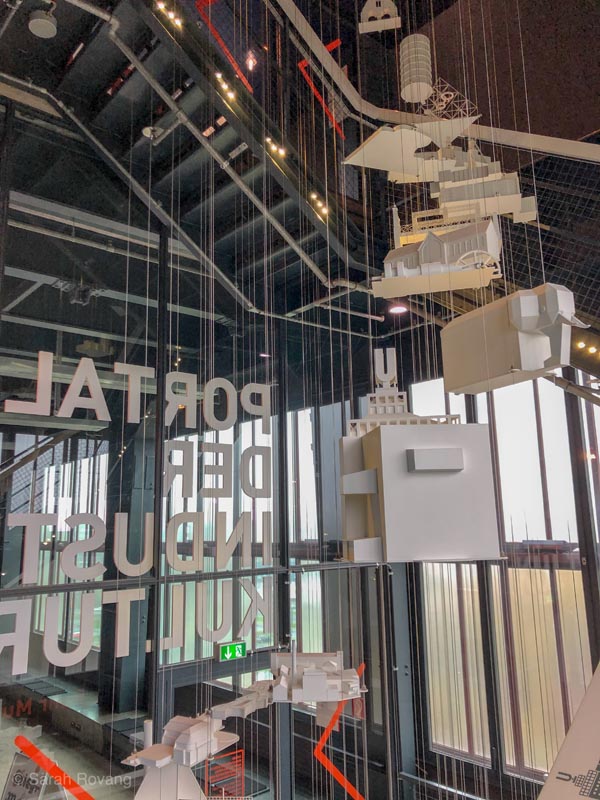
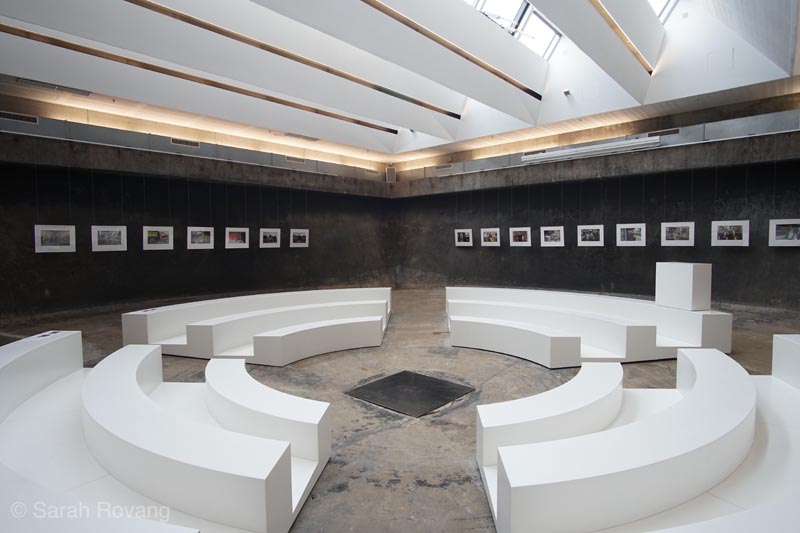
The Industrial Heritage Portal at the Zollverein UNESCO site. Models of each of the region’s thirteen industrial heritage “anchor points” hang in the stairwell leading up to the portal (above), which also houses a daylight gallery for contemporary art from the Ruhr Valley (below).
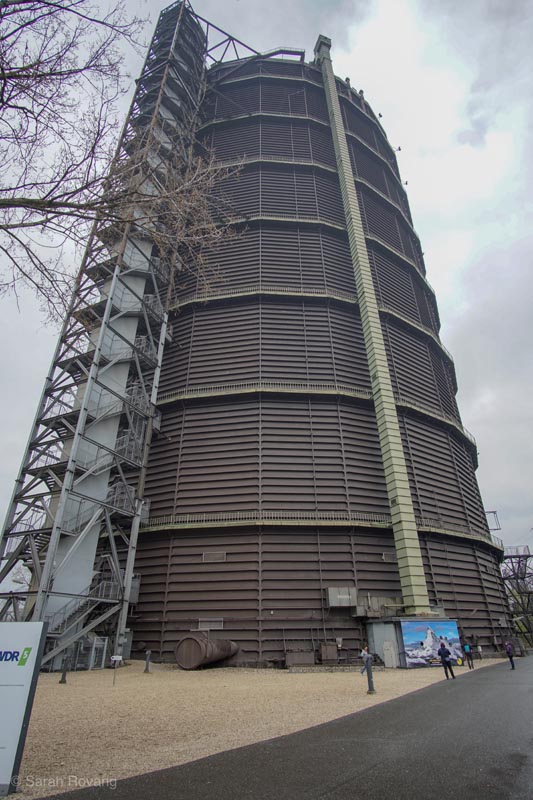
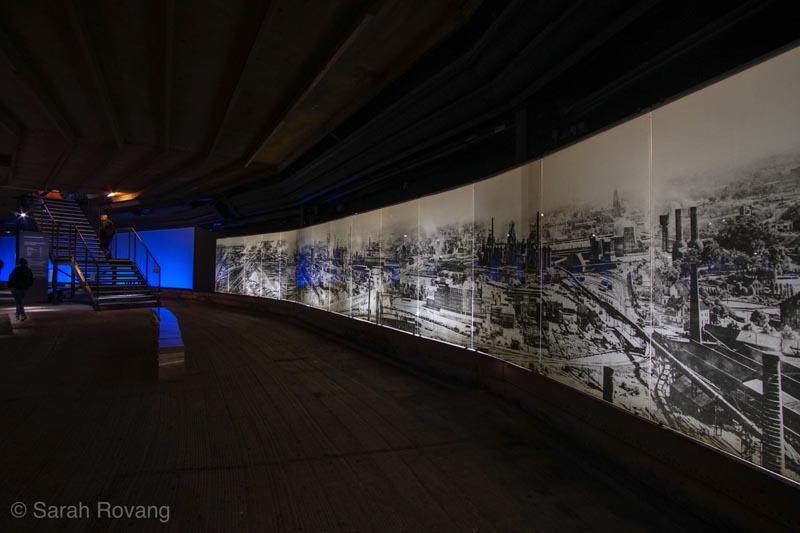
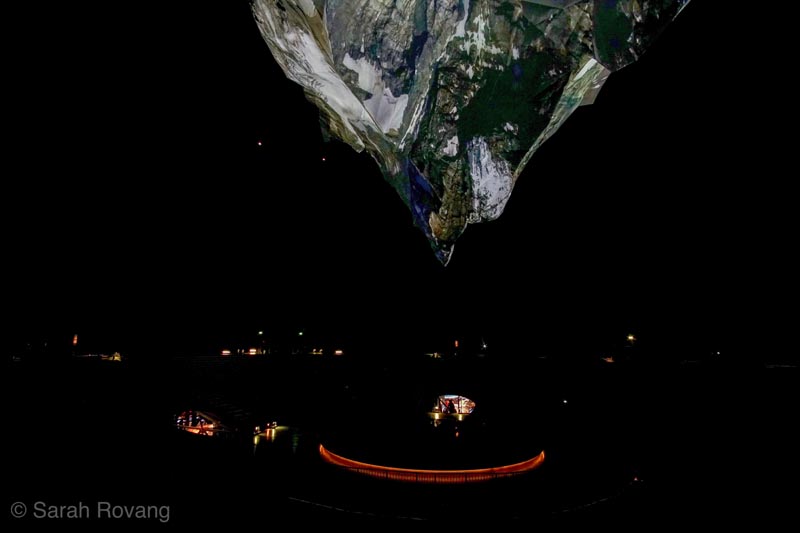
The Gasometer in Oberhausen is a 117.5 m tall 1920s German coking plant gas tank with 347,000 cubic meters of interior space. Today, it serves as a venue for educational exhibits and experimental art shows that try to maximize the Gasometer’s central space. When I visited, an exhibition entitled “Call of the Mountains” featured a dizzyingly immense scale model of the Matterhorn suspended upside-down from the ceiling.
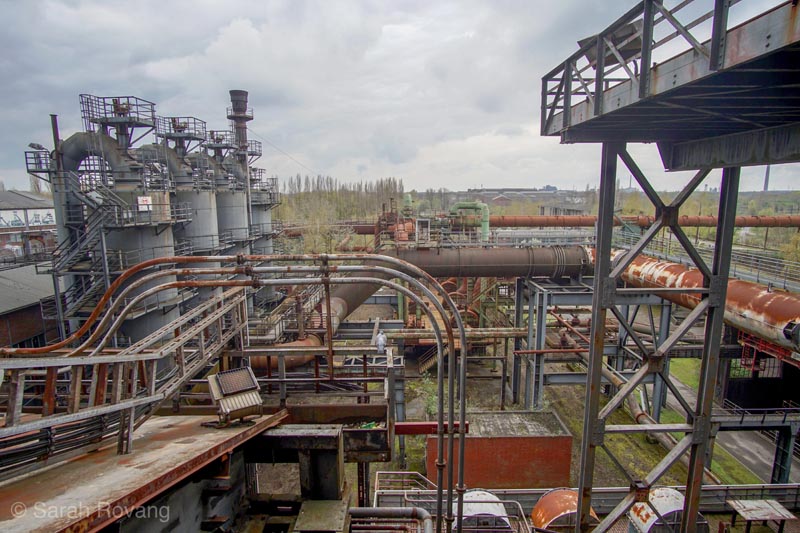
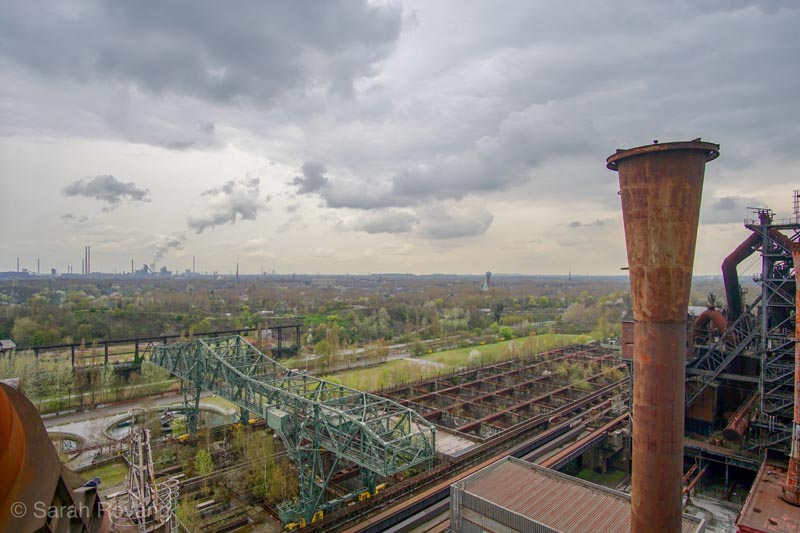
North Landscape Park in Duisburg is located on the site of the former Thyssen ironworks, which has been converted into a recreation space, complete with modernized stairwells and access routes that allow visitors to climb to the top of the towering blast furnace for an impressive view of the Ruhr valley.
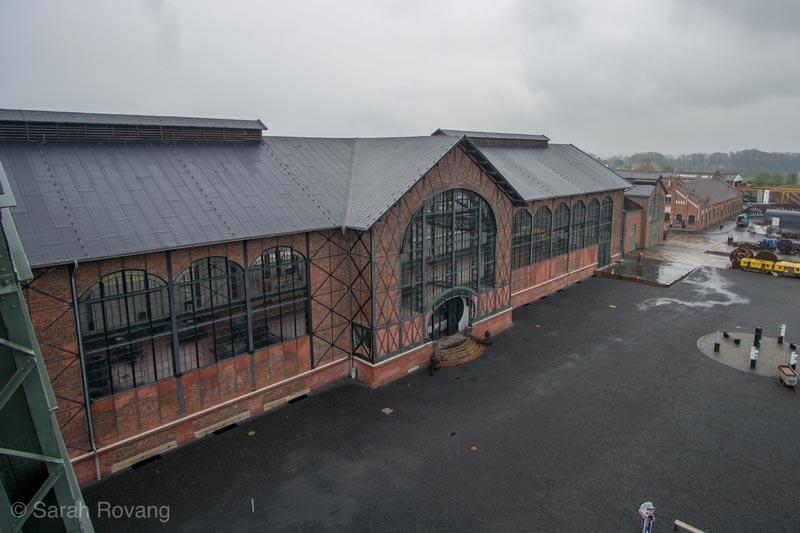
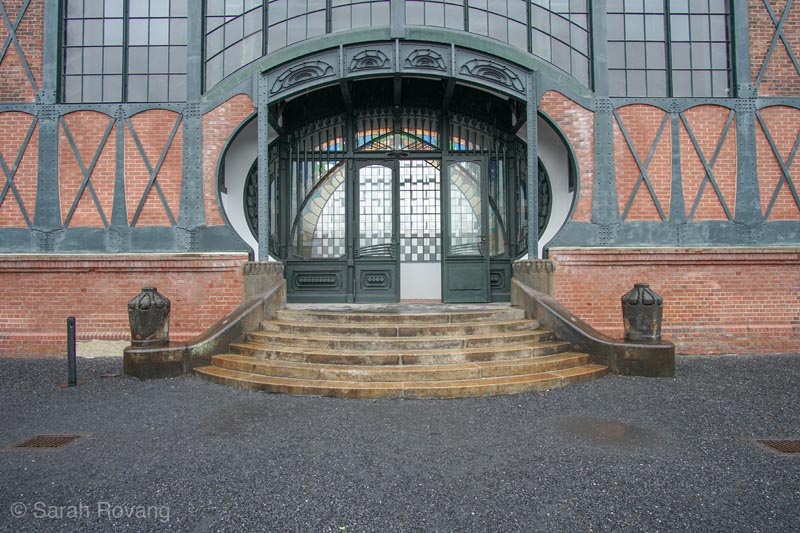
An earlier example of a showpiece colliery in the Ruhr region, Zollern is best known for its engine house, which features an elaborate Jugendstil entrance. The structure is used for a variety of concerts and other events.
Zollverein is one of the few industrial UNESCO sites I’ve visited that has capitalized fully on that status to promote tourism to the rest of the industrial landscape that it is a part of. Today, each of the thirteen “anchor points” of industrial heritage in the Ruhr Valley can be accessed via a 400 km bike loop (perhaps a goal for a future, fitter Brooks Fellow). Even though it is entirely possible to spend a full day in the coal washery’s interpretive center alone—as evidenced by my own experience—Zollverein functions as so much more than just a repository of industrial memory. The Red Dot Design Museum is the world’s largest museum repository of contemporary design items. Shops and artist studios line the industrial arcade of the Shaft XII complex. Out near the cokery, industrial buildings have been repurposed into offices and at the Shaft 1/2/8 complex, more office space and dining options have been added. In the summer, a swimming pool transforms the old coking plant into a playground, reimagining this former space of work as a space of recreation. The grounds of the colliery are open overnight and artistic night-lighting reinvents the appearance of the solid, Bauhaus masses, transforming them into glowing, apparently ephemeral structures.
Power in Numbers: The Mines of Wallonia
In the initial optimistic folly of my fellowship itinerary planning, I had decided that I would visit all four of the UNESCO-inscribed mines of Wallonia in southern Belgium. But, after some Belgian friends advised me that renting a car would be prohibitively expensive, Belgian drivers are terrifying, and public transit can be patchy in the truly suburban parts of the country, I scaled back my lofty goals and visited just two of the mines: the Bois du Cazier and the Grand Hornu. My selection was inspired in part by convenience (both are within two hours of Brussels) but mostly the unique ways in which their original structures are currently being reused to meet the needs of their communities.
After the United Kingdom, Belgium was the second-most industrialized nation in the world for much of the late nineteenth and early twentieth century. A visit the Industry Museum in Ghent reveals the intense atmosphere of competition that accelerated technological exchange, smuggling, and sabotage between the textile industries of Belgium and that of the UK. It was the coal-rich Walloon region to the south that supplied much of the energy powering the textile manufacture in Ghent and other industrial cities. As in the Ruhr Valley, Walloon industry fundamentally transformed both the economy as well as the very topography of the land, punctuating a largely flat, wooded area with the mounds created by coal slag. Now several decades removed from the end of coal mining activities in the region, those slag heaps are mostly covered with undergrowth and new trees.


The interior and exterior of the Industry Museum (MIAT) in Ghent, Belgium, a former cotton mill now converted into a museum about Belgian textile manufacturing. The mills of Belgium required vast amounts of power, much of which was provided by burning the coal sourced from the mines of Wallonia.
These humanmade hills are certainly a major attraction at the Bois du Cazier (operational 1822–1967), where bike and hiking paths lace the slag heaps directly adjacent to the mine. As I approached the site around noon, a dozen or so bikers were departing the heaps (also called terrils), and heading for a post-ride beer at the Bois du Cazier’s bar—a brilliant stroke of marketing on the part of the interpretive center. Compared to slag heaps, the historic site itself was significantly less busy; I was one of the few visitors out using the audio guide to explore the mining landscape. Perhaps best remembered as the site of a catastrophic mining accident in 1956 that claimed 262 lives, including many Italian immigrant workers, Bois du Cazier still serves an important memorial function for the surrounding community. Integrated within the heritage landscape are historical and contemporary memorials, both figurative and abstract, to the miners lost over sixty years ago. But although the site’s roles as both interpretive center for the former coal mine and memorial site are both prominent, these were by no means the only functions of the constituent structures, nor even their most important use. As the audio guide (which I discussed in last month’s audio blog post) led me around the site, I explored nearly a dozen structures that have been reused to serve a variety of purposes. In addition to the Industry Museum located in the former locker and shower rooms, the Bois du Cazier’s energy house has been reinvented as an event space, and the former forge area has become a working space for glass artists, abutting the new Glass Museum. This multivalent functionality as memorial, museum, and creative space is reflected in the recent addition of contemporary public sculptures that address the site’s coal mining history as well as its revitalized present. Recently-added signage has also expanded the focus of the site’s interpretation from the specificities of Bois du Cazier and the 1956 mine disaster to the issues of migrant labor more globally and across time.
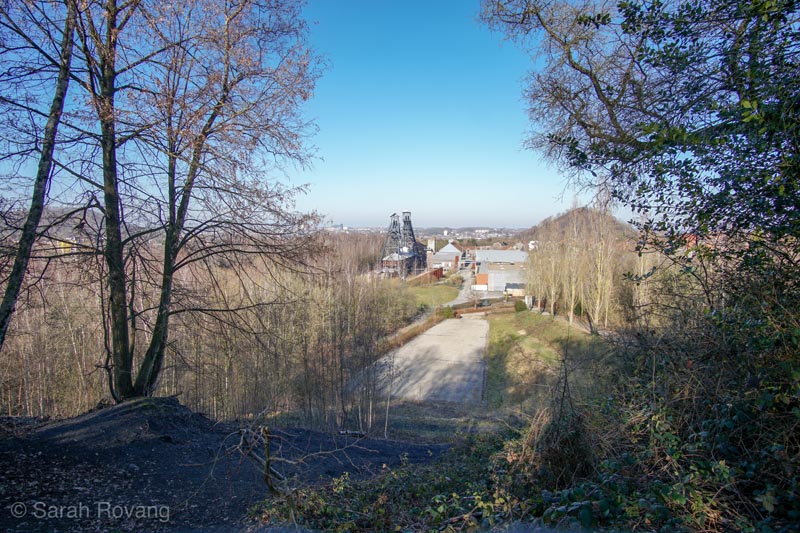
The view of Bois du Cazier mining complex from halfway up the nearby slag heap. The heaps (or terrils) have been re-forested in recent years and are now used for recreational hiking and biking.
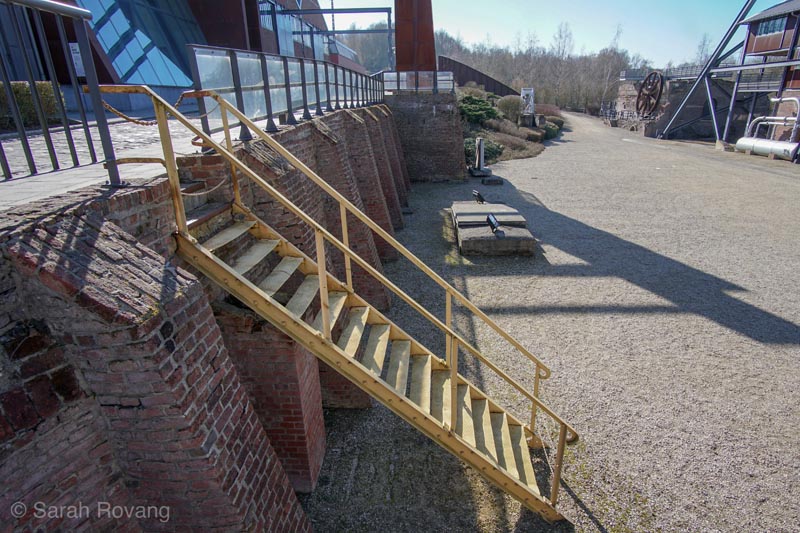
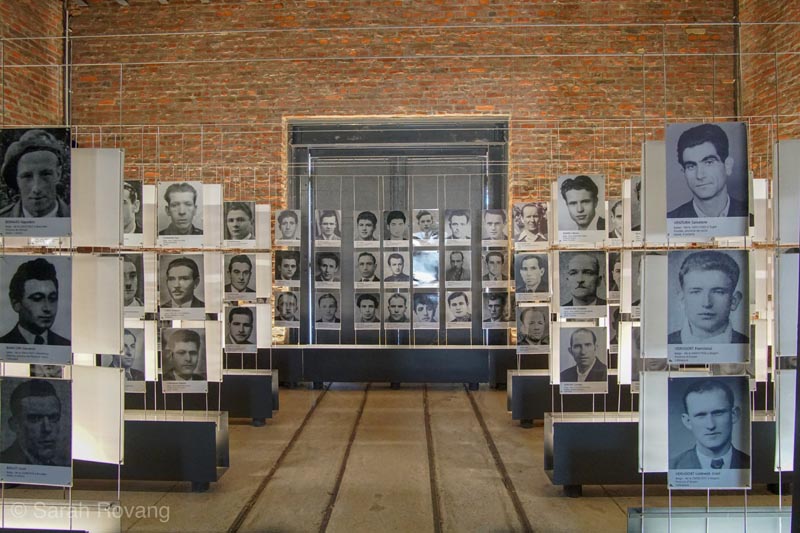
Above, this nondescript staircase at the Bois du Cazier became a theater for much of the action and many of the canonical photographs taken during the infamous mining accident of 1956. Today, the stairs are cordoned off, but have largely been left as they stood during the crisis. Between architectural remnants and more formal memorials, such as the one seen below, where the names of the victims are read aloud as part of a site-specific sound installation, much of the landscape of this UNESCO site is devoted to memorializing this epoch-making mine disaster. Indeed, the closure of the mine in the early 1960s can be attributed not only to declining profits from coal mining, but to the lingering stigma of the site following the tragedy.
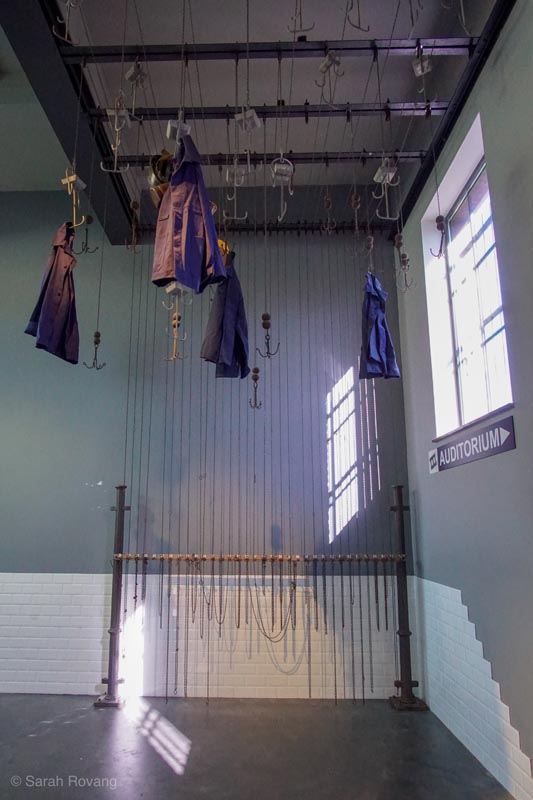
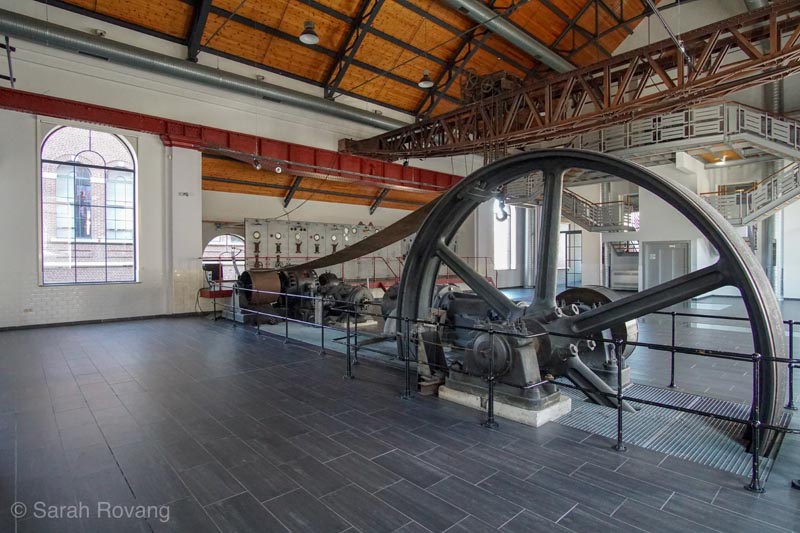
The Industry Museum (above) is installed in the liminal space where miners would have changed into and out of work clothes, picked up their head lamps, and showered after a long day in the mines. Some material culture from that period, such as the ceiling racks for hanging jumpsuits and equipment seen here, has been preserved as part of the display. Below, the former energy house has now been reused as event space, with much of the interior equipment cleared away to make room for large gatherings.
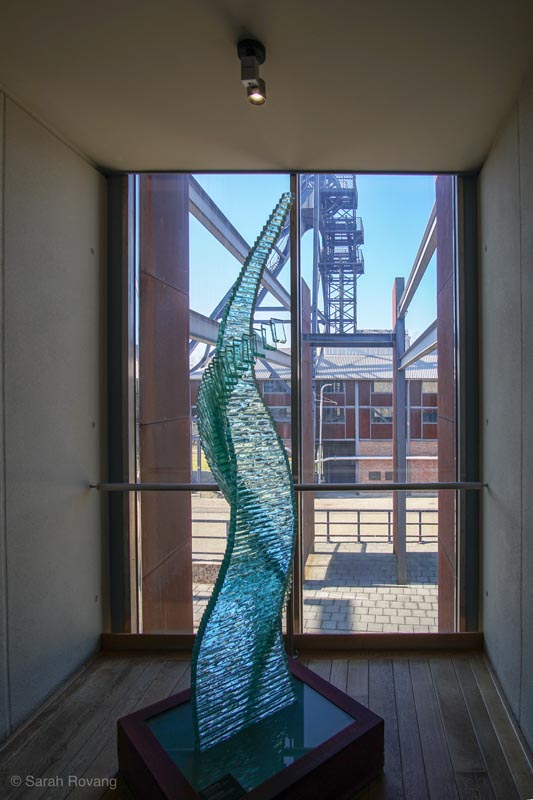
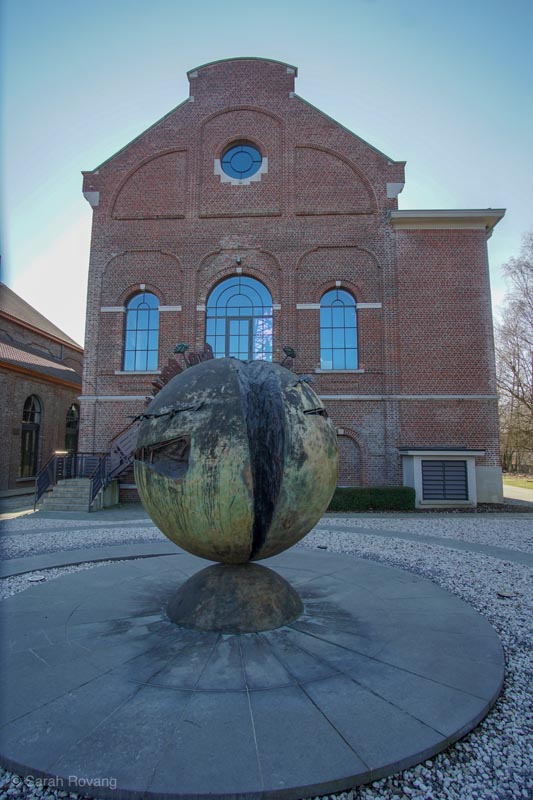
This niche at the Glass Museum (above) overlooks the main shafts and headgear of the Bois du Cazier. Below, a recent sculptural addition near the main interpretive space concerning the 1956 mine disaster confronts both the past and present of the UNESCO-listed mine.
The Grand Hornu has been even more extensively redeveloped for arts and cultural use. Saved from a bleak future as a parking lot in the 1960s by the activist and architect Henri Guchez, the Grand Hornu’s neoclassical Utopianism draws directly from the architecture parlante of Claude Nicolas Ledoux at the Royal Saltworks of Arc-et-Senans. Built between 1810 and 1830 by early industrialist Henri De Gorge as a model coal mining operation and company town, the Grand Hornu today has been converted into art exhibition space, including both the Centre d’Innovation et de Design au Grand Hornu (CID) and the Musée des Arts Contemporains de la Fédération Wallonie-Bruxelles (MAC’s). Elsewhere on the site, the former machine workshop, a cathedral-like ruin that once provided the necessary horizontal and vertical spans for working on large-scale machinery, is used as an occasional community theater venue. Other spaces in the ovoid court have been converted to offices for local businesses. As at Zollverein, I was surprised by the extent of overtly contemporary architectural interventions; with the contemporary addition of the MAC’s gallery (which opened in 2002, ten years prior to the site’s UNESCO inscription in 2012) forming a marked contrast in mass, material, and style to the rest of the historic site.
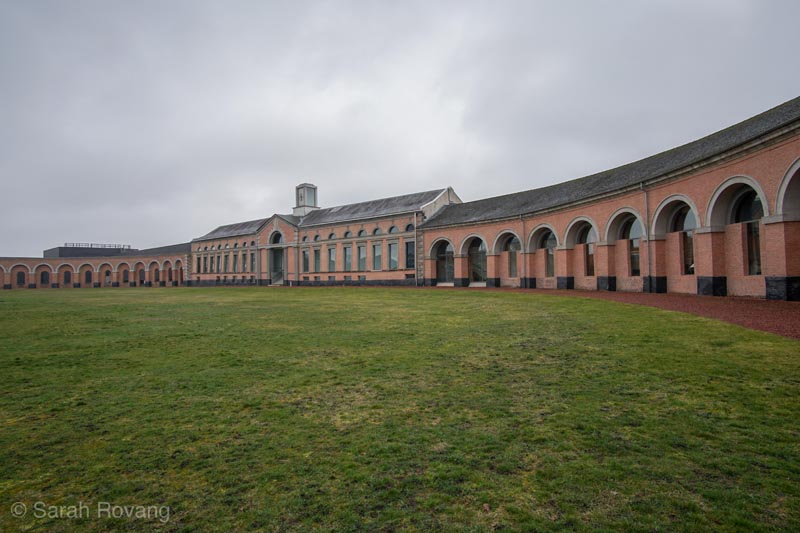
Part of the central oval courtyard of Grand Hornu; the former administration building shown at the center here has been taken over by Musée des Arts Contemporains de la Fédération Wallonie-Bruxelles (MAC’s).
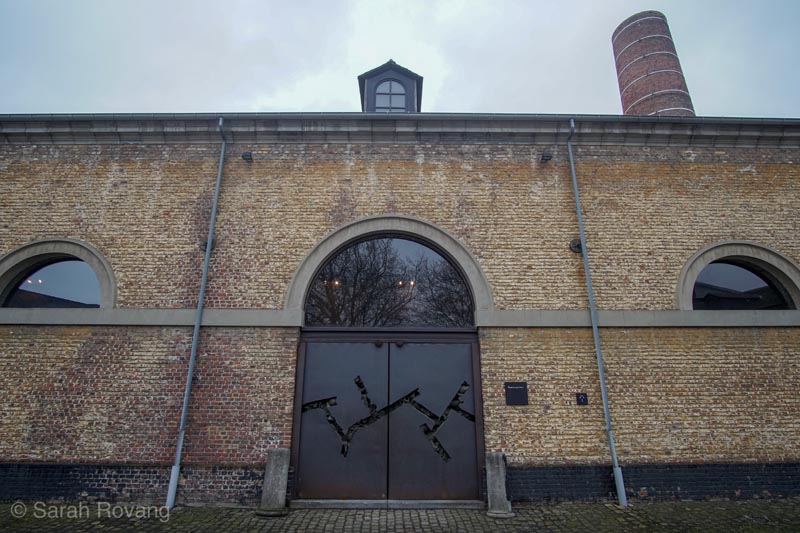
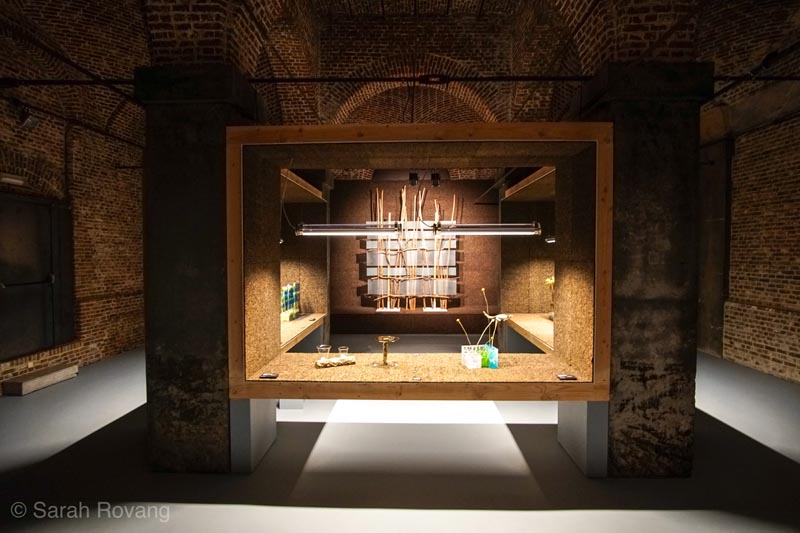
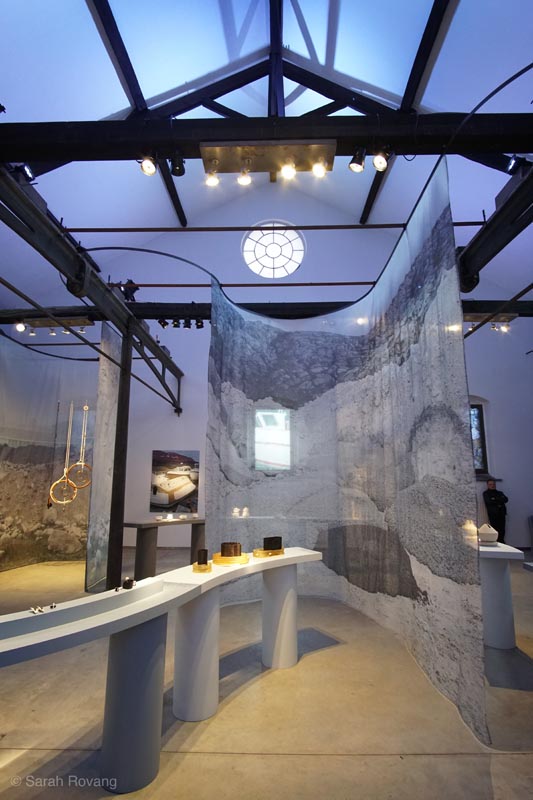
Above, the exterior of one of the two venues within the Grand Hornu now currently used by the Centre d’Innovation et de Design au Grand Hornu (CID). The design of the door is meant to evoke (both visually and tactilely) a coal seam, such as those historically mined at the site. In the center, an exhibition of award-winning present-day glass art produced through a collaboration with CID. Below, a show in CID’s other main venue at the Grand Hornu, which shares space with the main interpretive center and administrative offices for the historic site.
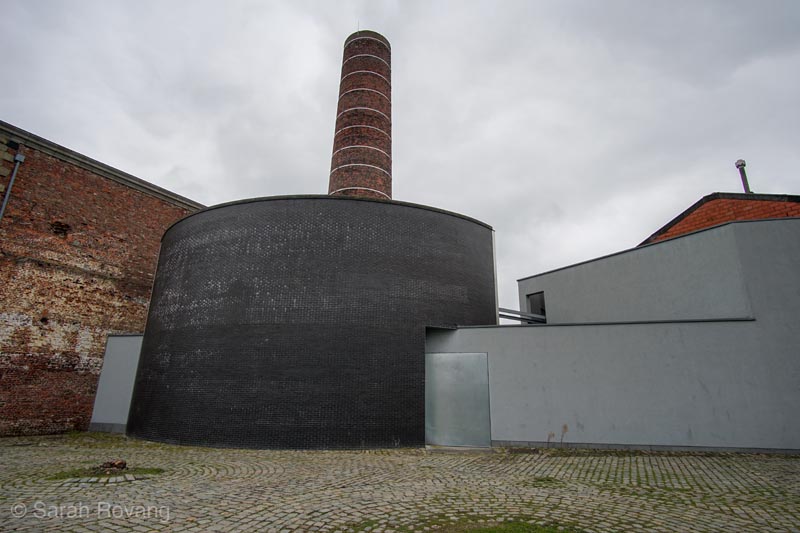
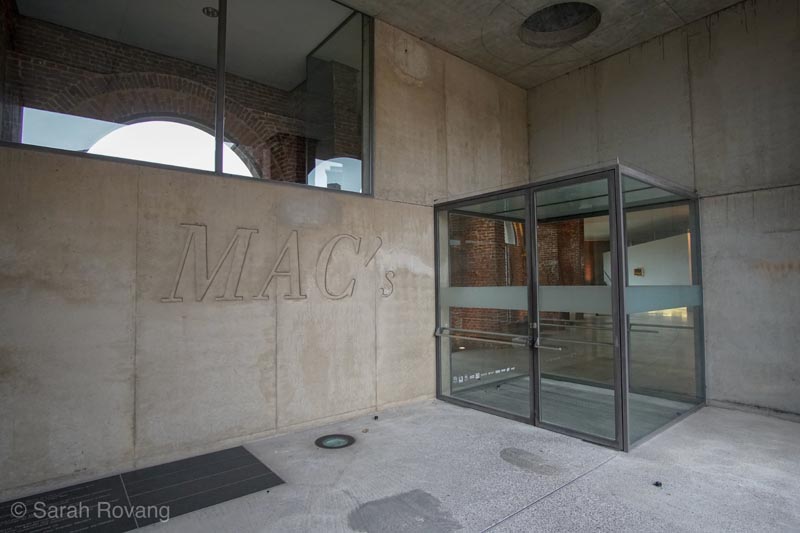
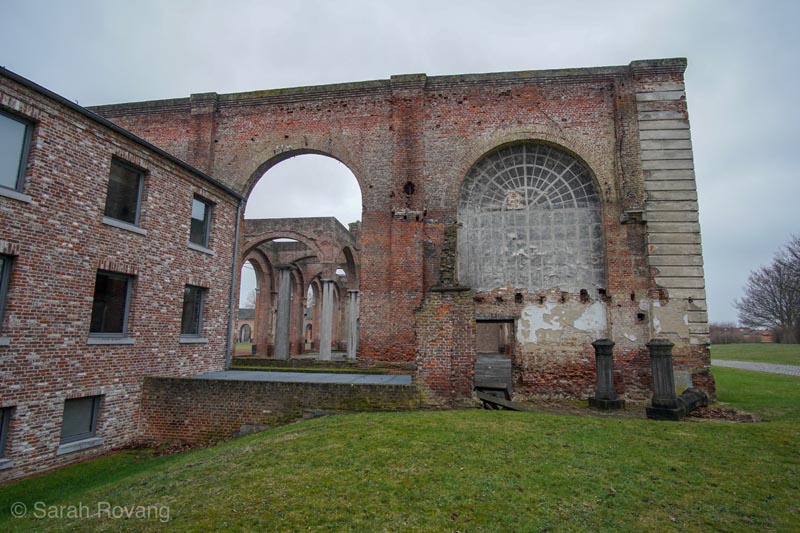
The above three images show the range of contemporary architectural intervention that has been made at the Grand Hornu site. Above, the combination of new construction and the historic smokestack shows the ways in which the site has been modified to serve the community and visitors. The curved structure in this photo is the exterior of the theater that typically shows a film about the site’s history. In the center, the all-new construction framing the entrance to MAC’s, and below, the former machine workshop that has been largely unaltered. This latter space is occasionally used for community events and theater productions.
The UNESCO inscription of the Wallonian mining region, with its four constituent sites, highlights the issues surrounding the duplication, competition, and co-listing of sites. What do UNESCO sites gain through a joint nomination that they would not on their own? Many of the sites that I’ve visited, particularly those inscribed within the past ten years or so, have featured unconventional nominating patterns, sometimes sharing an inscription across several sites within a country, or even across national borders.
In the case of Japan’s sites of the Meiji Industrial Revolution, many of the sites might not have had enough merit in terms of integrity or authenticity when considered individually, but when taken in total, constitute a compelling heritage landscape that cumulatively tells a fuller, richer story about Japan’s singular process of industrialization. The mercury mine in Idrija, Slovenia is also part of a joint listing along with Almadén, Spain. Historically, these two sites alternately competed and collaborated, together responsible for 48% of the world’s total mercury production. That historical relationship is preserved in the terms of the UNESCO nomination, which recognized the sharing of technology and expertise between the two sites over several hundred years.
These kinds of joint or group nominations can be successful not only because they link several sites into networks based on related historical and architectural issues, making inscription possible for more sites, but because they have the capacity to call attention to wider heritage landscapes. At the Grand Hornu, one of the docents I met is working to save the Belgian coal mine where a young Vincent Van Gogh once evangelized to miners in his brief career as a priest (you can read more about this effort here). Additionally, even though the four inscribed mines of Wallonia vary significantly in terms of their historical contexts and architectural content, they speak to a broader and more enduring set of relationships between humans and fossil fuels during the nineteenth and twentieth century. As at Zollverein, the cultural visibility of the Walloon mines as UNESCO sites might spur broader discussions about how to reinterpret and reuse industrial spaces not only within the confines of the inscribed areas, but also regionally or even nationally.
The Fagus Factory: UNESCO, Privatized
It took me five trains to get from suburban Essen to Alfeld on a Sunday morning in April, and another three to reach Berlin later that day. But the intervening stop was worth it—a visit to the Walter Gropius-designed Fagus Factory (1911–1925) where I learned a lot about architecture, and more surprisingly, a lot about about shoe manufacturing, sustainable timber management, and foot ergonomics. During my five hours there, I watched a half-dozen tour buses arrive and depart (from what I could tell, mostly retired Germans). I was one of the sole international visitors, and one of the few who had arrived by rail. On the walk from the train station, I noted the standard German mining symbol prominently displayed on another factory or warehouse, and the cluster of industrial buildings around the rail corridor.
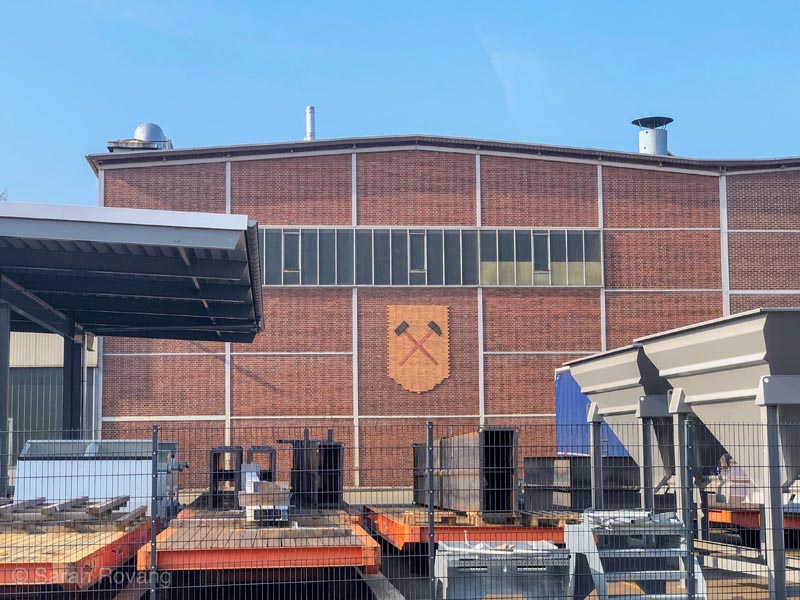
The ubiquitous symbol of German mining, which recurs across historic industrial sites nationwide.
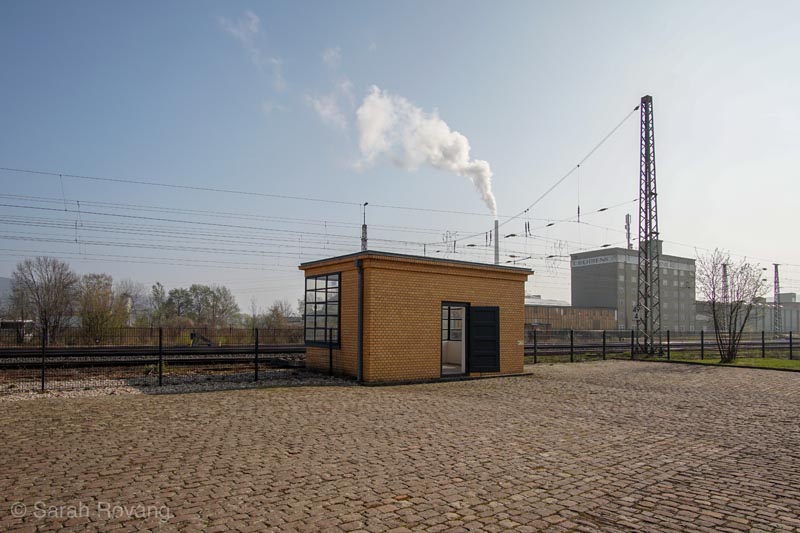
The Carl Behrens corporation was once the employer of Carl Benscheidt, who founded the Fagus Factory. As in many other small, industrial European cities, the factories of Alfeld cluster around the railroad conduit. Knowing that the new Fagus building would be sited such that rail passengers could see it, Walter Gropius endeavored to create an architectural design that would function as an advertisement for the Fagus brand.
The vast majority of UNESCO industrial heritage sites I’ve visited are no longer operational. In some cases, such as the mercury mine in Idrija, they have been closed for environmental and public health reasons, in addition to the more common economic reasons for closure (such as textile manufacturing moving to Asia). For those sites that still serve their original industrial purposes, frequently the operation has changed hands, or in the case of Sewell Mining Town (where the original 1910s copper concentrator is still in use), the El Teniente mine was nationalized along with the rest of Chile’s copper industry back in the 1970s. The Fagus Factory is one of the rare instances I’ve observed of an industrial UNESCO site that is still being used, at least partially, to serve the same industry for which it was built, and even rarer, to serve the same corporation and family of owners.
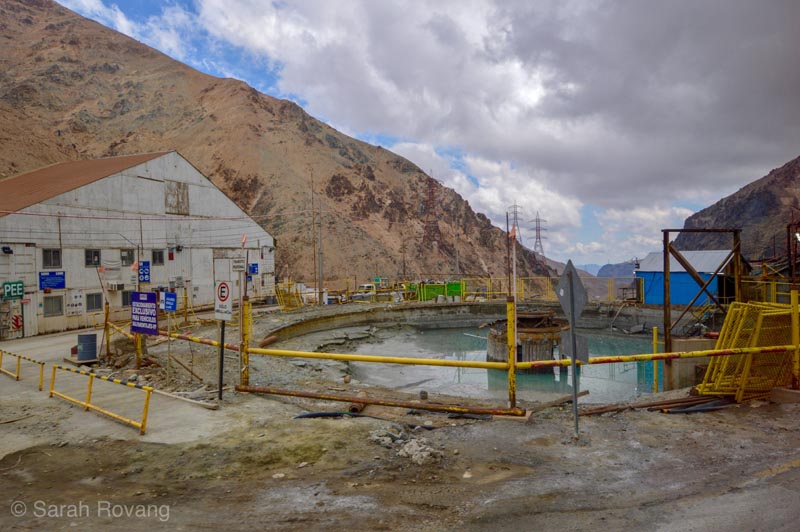
Operational for over a century, the Sewell concentrator is still used at the El Teniente copper mine, even though miners no longer live in Sewell.
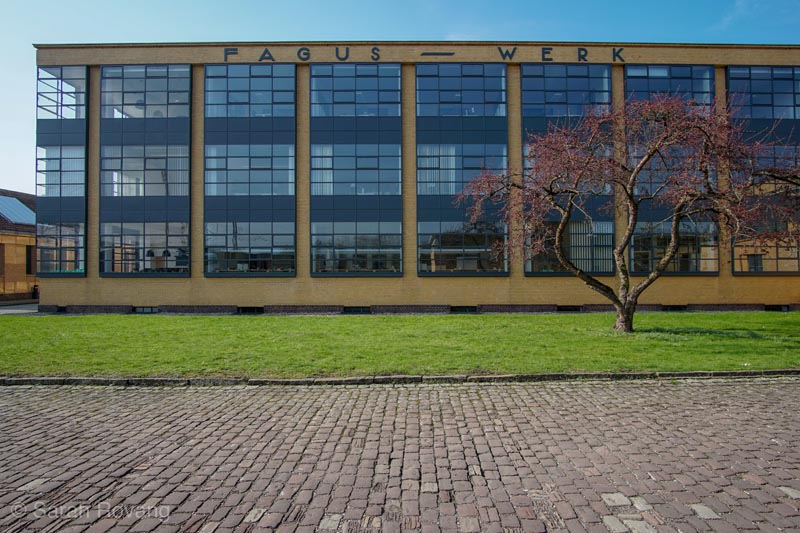
![]()
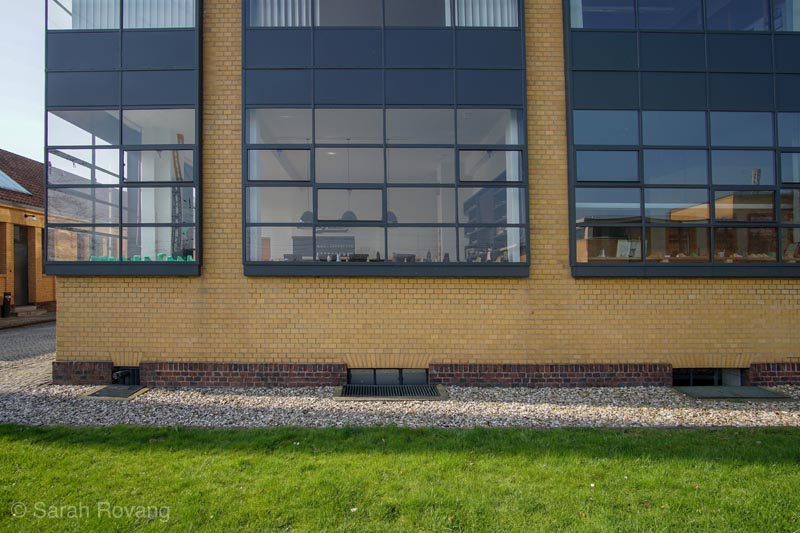
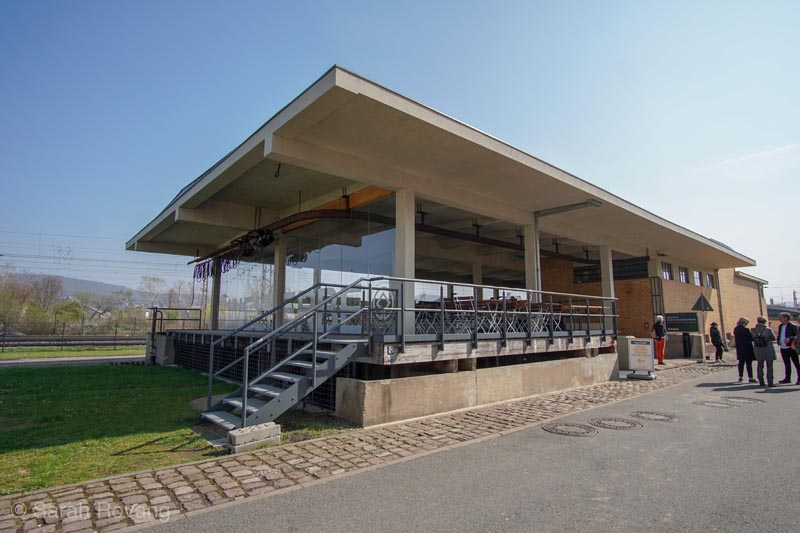
Most of the component structures within the Fagus Factory complex are still used in the shoe last designing and manufacturing process. The original offices are still used as offices (top three photos), including the design workshop (second from the bottom). Below, the historic Chips House has been converted into the main UNESCO interpretive center.
Correspondingly, and in contrast with the many publicly-administered UNESCO sites I’ve visited, the Fagus Factory is very much a corporate museum, in the same vein as the Mitsubishi Pattern Factory in Nagasaki, Japan. However, unlike the Pattern Factory, which has been entirely converted into interpretive space even though it stands on land owned by Mitsubishi Heavy Industries, the Fagus Factory still functions much as it did 100 years ago, with the exception of the beechwood warehouse, which has been converted into a museum space. Beech shoe last originals are still created by trained artisans at the site, but today those wood originals are now scanned and converted to mass-produced plastic lasts for distribution to clients.
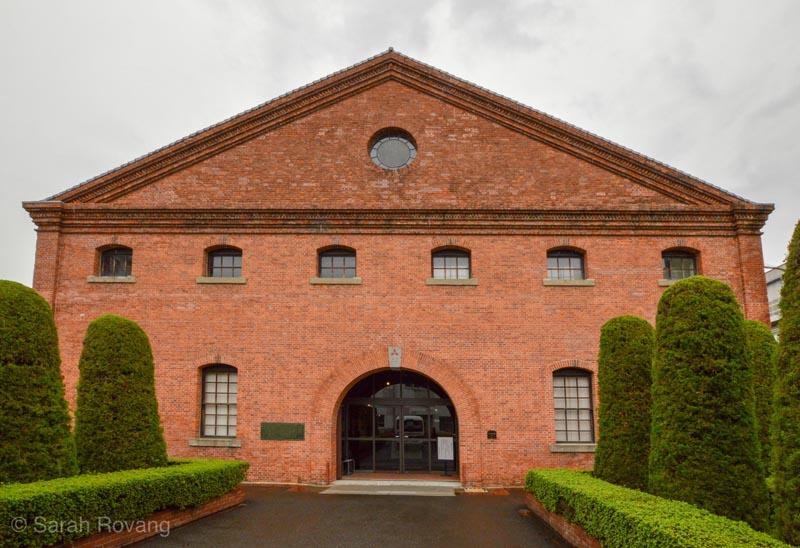
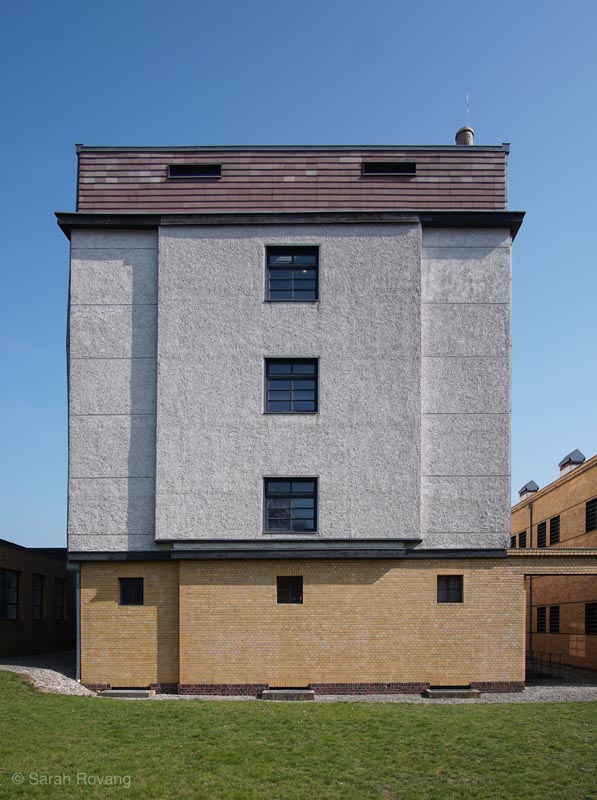
Above, the 1898 Mitsubishi Pattern Factory in Nagasaki, Japan is still on land owned by Mitsubishi and is available for tours by appointment only. It no longer serves an active industrial function and has been converted entirely to a museum. By contrast, at the Fagus Factory, of the original buildings only the warehouse (seen below) has been entirely moved over to an interpretive role. While other parts of the factory complex have been updated to use new, computer-aided workflows, the structures are still being used for the design and production of shoe lasts. The warehouse, which is originally where the beechwood for the lasts was dried for many months, is no longer needed because only one copy per shoe design is now modeled by hand out of beech—the actual shoe lasts used by the Fagus Factory’s clients are now made from durable, long-lasting plastic.8
On the plus side, the intimate relationship between technical function and built form was very well articulated and approachable from the standpoint of public storytelling—through the well-crafted audio guide I came to appreciate how each architectural volume and choice of building material corresponded to a particular workflow within the shoe last manufacturing process. In the exhibition building (formerly the warehouse), the original wood slat floors have been preserved, including the 3–4 cm gaps between slats that originally facilitated air flow and ventilation for the drying beechwood. But, at the same time, corporate promotion suffuses every aspect of the site’s interpretation. The main museum felt a bit like a giant advertisement, recalling other contemporary corporate museums I’ve visited during my travels (the Cup Noodle Museum in Yokohama or the Toto Museum in Kitakyushu, e.g.). The multimedia audio guide provided the expected information about a young Walter Gropius’s design innovations, but also a three minute video about Fagus GreCon’s modern spark-suppression system, developed as a byproduct of working with dry-beech sawdust on an industrial scale for over 100 years.
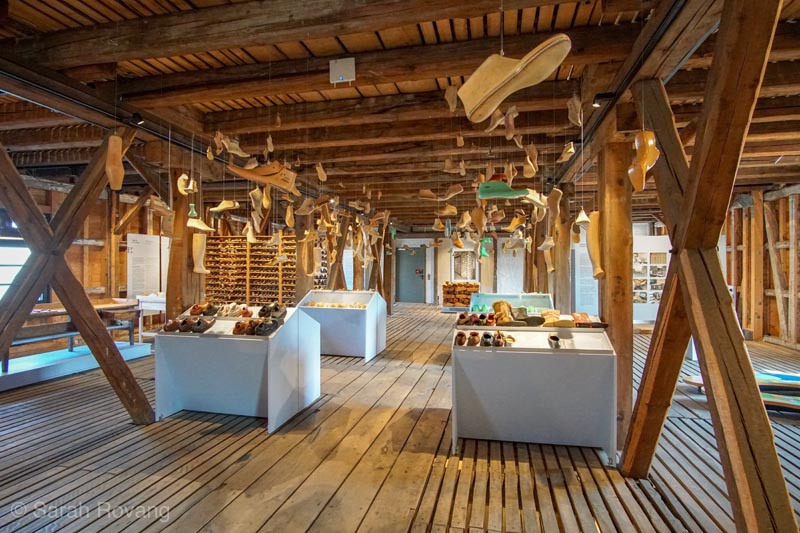
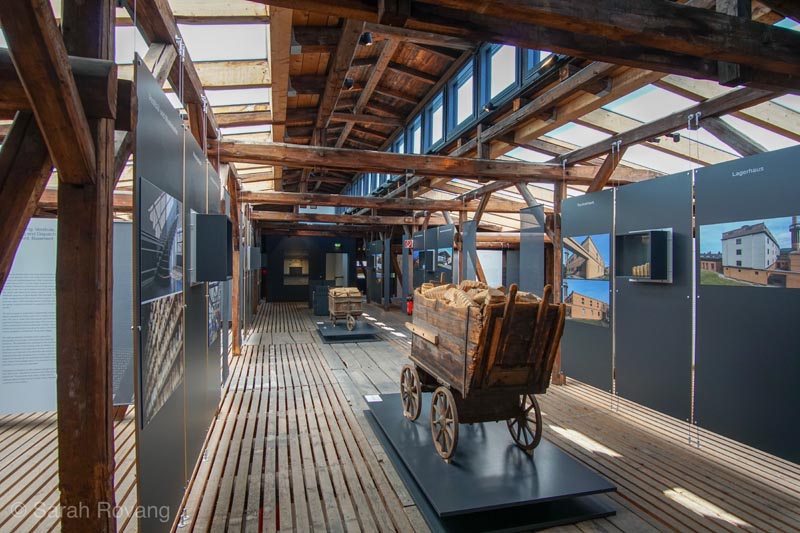
Two images from inside the interpretive center, now located in the former beechwood-drying warehouse. The well-ventilated wood-slat floor really required some sturdy German reform shoes—the flat-soled 1910s precursors to modern orthopedic shoes that I learned about in the several exhibitions devoted to shoe design and foot health history.
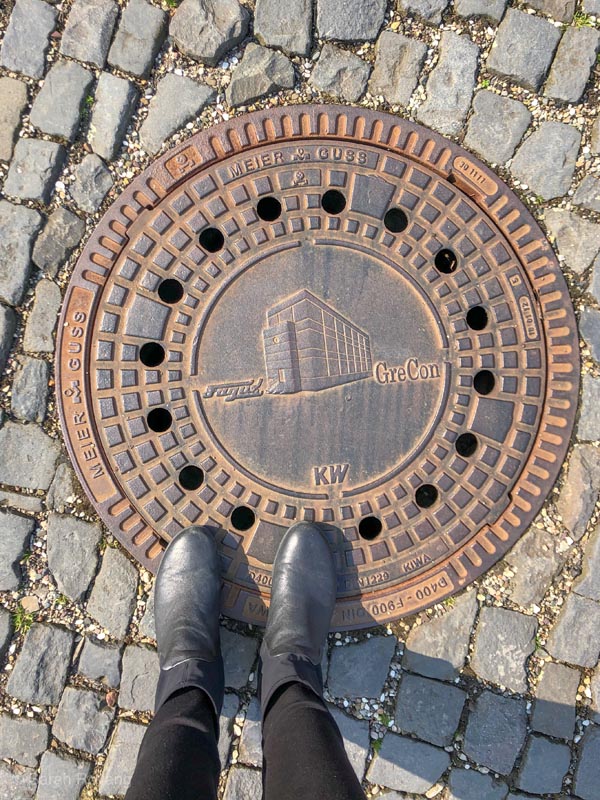
Branding at the Fagus Factory extends all the way to manhole covers.
Somewhat frustratingly, while many portions of the museum dealing with the restoration of the buildings in advance of the UNESCO nomination, the manufacture of shoe lasts, and the development of the German shoe industry are bilingual, most of the more academic portions pertaining to the historic architecture of the building are only in German. Compared to many German sites I visited that directly confronted their participation and sometime complicity in the Nazi war machine, the Fagus version of history seemed (at least in its English translation) to elide many of the more difficult questions around the company’s WWII past. Furthermore, the interpretation focused largely on the corporate protagonists behind the site’s restoration, a “great man” version of recent history that was also typical in many of the Japanese sites I visited last year. In a representative passage in the display about the restoration of the site’s architecture, Ulrich Pagels, a supervisor of the project and senior conservator of monuments, is quoted as saying:
It was Ernst and Gerd Greten, the persons in charge throughout - with a visionary approach - who fought for the optimization of existing concepts...The warehouse’s hidden potential, recognized and developed by the Greten brothers in a courageous manner, could thus be put to optimal use for the company. The potentially conflicting framework of commercial aims on the one hand, and government restrictions and impositions on the other, was thus resolved. Nowadays, the exhibition displays a particular historic flair, thanks to its beautifully restored, timber-framed fabric.9
The inherent assumptions behind this statement, including the notions of “optimization”, “putting to optimal use,” and capitalizing on “historic flair,” suggest that heritage exists mostly as a potentially lucrative resource—but one that can be potentially restrictive or problematic for the modern capitalist corporation. This view of heritage as having additive corporate value seems to run counter to the UNESCO belief that certain heritage sites possess intrinsic “global value,” which can be judged according to the criteria of integrity and authenticity.
The Fagus Factory thus reveals the uneasy coalition of corporate culture and global heritage. By investing heavily in the history of the Fagus Factory, the current Fagus GreCon corporation has created an intense dependency on the continued preservation and maintenance of the historic Fagus site. At the same time, the interpretive landscape of the site is dominated and controlled by corporate narratives, which may ultimately serve to limit or circumscribe the range of possible future interpretations.
The Archival Compulsion and Future-Proofing the Heritage Landscape
Over the last twenty or so years, UNESCO’s efforts to diversify its list have led to the rapid-fire addition of new kinds of sites and listings, including the industrial heritage hubs, co-listings, and privatized sites described in the previous case studies. Notably, this infusion of “new heritage” has not been accompanied by a corresponding re-evaluation of older, existing inscriptions, even after the World Heritage Convention concluded that certain types of sites are over-represented.
In a chapter entitled “Heritage and the ‘Problem’ of Memory,” scholar Rodney Harrison argues that the idea of “global heritage” is a fundamentally constructed category, one that may not always have the same cultural relevance or content that we ascribe to it today.
If heritage is not a universal category of value, then it follows that certain aspects of heritage will at some point cease to be relevant and should be discarded. Instead, our approach has tended to be one that continually lists ‘new’ heritage without considerations of the values embodied in our past conservation decisions. I suggest that as a result of this, we face a coming ‘crisis of accumulation’ of the past in the preset in the early twenty-first century, which will ultimately undermine the role of heritage in the production of collective memory, overwhelming societies with disparate traces of heterogenous pasts and distracting us from the active process of forming collective memories in the present.10
Harrison points out that as of 2012 only 2 sites out of over 1000 UNESCO sites have ever been de-listed.11 In other words, because sites are so rarely de-listed, the UNESCO list has become a de facto archive not only of heritage sites, but of changing cultural beliefs and assumptions about the nature of heritage itself. What will happen in the future, if the rate of UNESCO inscriptions continues at its current rate, or even begins to accelerate? Harrison argues that, as psychologists have suggested about individual human memory, intentional forgetting (in this case, the purposeful de-listing of sites), is critical to the formation of cogent historical memory on the societal scale. Whether or not this controversial option is feasible or advisable is too much to address fully within the scope of an SAH blog post, but I do think it is reasonable to state that at some point in the future, all of the industrial heritage sites added to the list between 2001 and 2020 will not have the identical cultural meaning or importance that they do during this particular historical moment. But even as conceptions of “global heritage” fluctuate and interest in industrial heritage waxes and wanes, the three sites and groups of sites described in this post have maximized their chances at viability in the long term, by creating programs that render their architecture and heritage landscapes relevant across a variety of audiences and uses. By revivifying these industrial heritage sites with new uses rather than solely construing them as mausoleums or monuments to a previous era, their curators, architects, and preservation experts have forged a usable past—a tangible and inclusive link between Europe’s industrial past and its post-industrial present.
- Aurélie Élisa Gfeller and Jaci Eisenberg, “UNESCO and the Shaping of Global Heritage,” A History of UNESCO, P. Duedahl, ed. (New York; London: Palgrave Macmillan, 2016), 286. ↩︎
- Ibid., 287. ↩︎
- Michael Falser, “Is Industrial Heritage under-represented on the World Heritage List?” Global Strategy Studies: Industrial Heritage Analysis, World Heritage List and tEntative List, UNESCO World Heritage Centre, 2001, 9. ↩︎
- Ibid., 13. ↩︎
- Gfeller and Eisenberg, 287. ↩︎
- Gfeller and Eisenberg, 288. ↩︎
- “Did you know... where the longest and highest open-air moving staircase in Germany can be found?” European Route of Industrial Heritage, accessed April 29, 2019, https://www.erih.net/did-you-know/question///where-the-longest-and-highest-open-air-moving-staircase-in-germany-can-be-found/ ↩︎
- On-site audio guide information, accessed April 6, 2019. ↩︎
- Ulrich Pagels, quoted in on-site signage at the Fagus Factory, photographed April 6, 2019. ↩︎
- Rodney Harrison, Heritage: Critical Approaches (New York: Routledge, 2013), 166. ↩︎
- Ibid., 169. ↩︎



Leave a commentOrder by
Newest on top Oldest on top